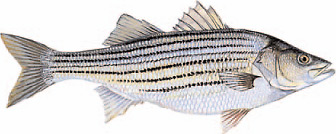 Scientific Name
Scientific Name
Morone saxatilis
Other Common Names
striper, rockfish
Identification
True bass family. Streamlined, elongate body; coloration shades from dark olive above through silvery sides to a white belly; 7 to 8 prominent unbroken black stripes originate behind the head and extend to the tail; more prominent than on the white bass. Two spines on the gill cover; two patches of teeth on tongue. Ten to 15 lb. fish are common with 30 to 40 lb. + fish landed each season.
Best Fishing
Lakes: Smith Mountain, Buggs Island, Anna, Claytor, Gaston, Leesville and Western Branch. Rivers: Staunton/Roanoke and all tidal rivers.
Fishing Techniques
Heavy baitcasting, spincasting or spinning outfits with a good backbone and 15 to 25 pound test line. Live bait includes large minnows or gizzard or threadfin shad. Large feathered or plastic jig combinations, spoons, crankbaits that imitate shad or other fish and bucktails. Trolling, drift fishing, jump fishing or deep jigging are usual fishing methods.
Feeding Habits
Like other temperate bass, they travel in schools, feeding in openwater on smaller schooling fish, such as gizzard shad.They also eat a variety of insects and aquatic organisms.
Habitat
By nature, stripers are anadromous, spending most of their adult lives in saltwater, making spring “spawning runs” to freshwater tidal rivers. However, this species has been successfully stocked in freshwater lakes, and landlocked stripers have been established in several lakes around the state.
Spawning Habits
Each spring anadromous stripers move from the ocean and Chesapeake Bay to spawn in freshwater reaches of tidal rivers. Landlocked stripers migrate up tributary rivers of larger reservoirs to spawn, often just below dams or upstream obstructions. When water temperatures are from 55° to 60°F, the females deposit their semi-buoyant eggs in the current. They are fertilized as they are being released, and they stay afloat until the fry hatch out.
How DWR’s Work Benefits Striped Bass

Into the World: Harvesting and Releasing Striped Bass
Take a look at the methods used by warm water hatchery staff to harvest fish from production ponds for stocking in reservoirs such as Bugg's Island Lake. Watch…

Hatching and Raising Striped Bass for Stocking Virginia’s Lakes
Join Hatchery Manager Mike Gafford as he explains the methods employed by his crew to collect, produce, and raise striped bass for stocking in lakes around Virginia. Watch…

Kerr Lake Striped Bass Sampling
DWR aquatic wildlife resources staff sample the Striped Bass population in Bugg's Island Lake / Kerr Reservoir annually to assess abundance and growth rates. Watch…


